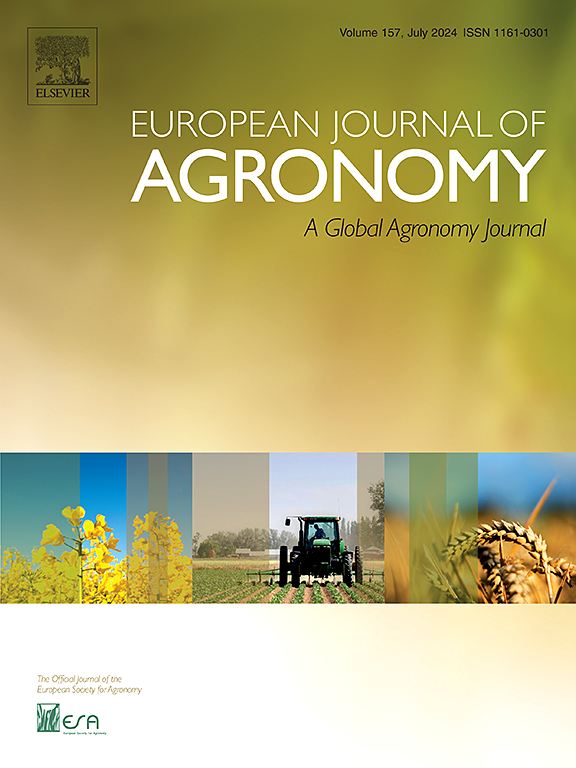间作设计对物种混合杂草抑制的影响:基于模型的探索
IF 4.5
1区 农林科学
Q1 AGRONOMY
引用次数: 0
摘要
间作加强杂草抑制的报道屡见不鲜。最近一项结合植物竞争模型和经验数据的研究表明,杂草抑制的改善是一种所谓的选择效应,即杂草抑制作物种类越多,间作的杂草抑制能力就越大。本研究在此基础上,利用植物竞争模型探讨了间作系统的物种组成、混合比例、种植密度和空间安排对杂草抑制能力的影响。分析发现,物种组成是主要的设计因素,因为作物物种之间抑制杂草能力的差异是造成间作杂草抑制高于平均水平的主要原因,这种差异越大,影响越强。由于作物品种间的抑杂草能力差异很大,即使是一小部分抑杂草较强的品种也能大大提高间作的抑杂草能力。在这种情况下,混合比例可以用来调节杂草抑制和竞争力较弱的作物物种被过度生长的风险之间的权衡。如果作物种类表现出相似的杂草抑制水平,植物密度被发现是一个有用的调节剂。在这种情况下,添加设计的间作是增强杂草抑制的唯一选择。组份种的接近性被证明是优良杂草抑制的先决条件。因此,在带状种植制度下,随着带状的扩大,其抑制杂草的能力迅速下降。获得的定量见解为设计多功能年际间作系统时考虑杂草抑制提供了理论基础。本文章由计算机程序翻译,如有差异,请以英文原文为准。
The impact of intercrop design on weed suppression of species mixtures: A model-based exploration
Intercropping has frequently been reported to enhance weed suppression. A recent study combining a plant competition model and empirical data demonstrated that improved weed suppression results from a so-called selection effect, whereby the more weed suppressive crop species contributes disproportionate to the weed suppressive ability of intercrops. Here, we build on this finding and used the plant competition model to explore how species composition, mixing ratio, planting density and spatial arrangement influence the weed suppressive ability of annual intercropping systems. Analysis identified species composition as the principal design factor, since a difference in weed suppressive ability between crop species appeared the prime driver responsible for the above-average weed suppression of intercrops: the larger this difference the stronger the effect. With greatly differing levels of weed suppressive ability between crop species, even a small proportion of the stronger suppressive species greatly enhanced the intercrop’s ability to suppress weeds. In such a situation, mixing ratio can thus be used to regulate the trade-off between weed suppressiveness and the risk of the less competitive crop species being overgrown. Plant density was found to be a useful modulator if crop species displayed similar levels of weed suppression. In this case, intercrops in additive design were the only option to enhance weed suppression. Proximity of component species proved a prerequisite for superior weed suppressiveness. Consequently, in strip cropping systems, the improved weed suppressive ability rapidly declined with wider strips. The acquired quantitative insights form a theoretical foundation for considering weed suppression when designing multifunctional annual intercropping systems.
求助全文
通过发布文献求助,成功后即可免费获取论文全文。
去求助
来源期刊

European Journal of Agronomy
农林科学-农艺学
CiteScore
8.30
自引率
7.70%
发文量
187
审稿时长
4.5 months
期刊介绍:
The European Journal of Agronomy, the official journal of the European Society for Agronomy, publishes original research papers reporting experimental and theoretical contributions to field-based agronomy and crop science. The journal will consider research at the field level for agricultural, horticultural and tree crops, that uses comprehensive and explanatory approaches. The EJA covers the following topics:
crop physiology
crop production and management including irrigation, fertilization and soil management
agroclimatology and modelling
plant-soil relationships
crop quality and post-harvest physiology
farming and cropping systems
agroecosystems and the environment
crop-weed interactions and management
organic farming
horticultural crops
papers from the European Society for Agronomy bi-annual meetings
In determining the suitability of submitted articles for publication, particular scrutiny is placed on the degree of novelty and significance of the research and the extent to which it adds to existing knowledge in agronomy.
 求助内容:
求助内容: 应助结果提醒方式:
应助结果提醒方式:


